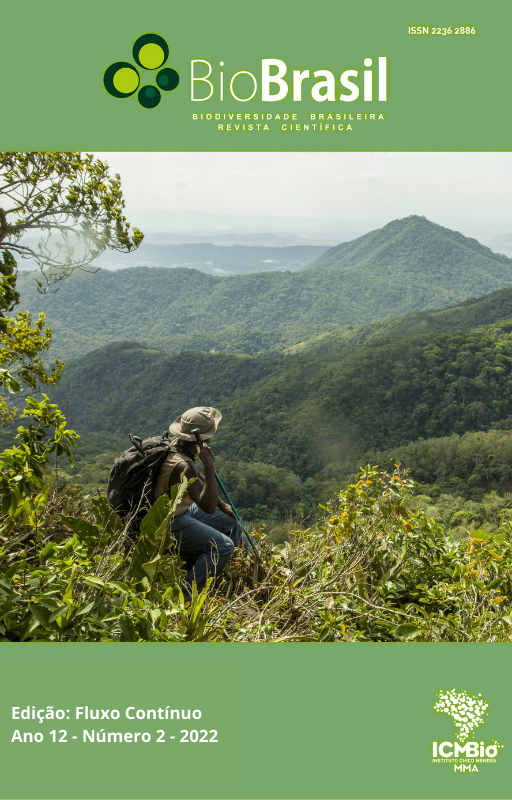Consumo de Plantas Ornamentais e os Impactos Iniciais da Pandemia de Covid-19
DOI:
https://doi.org/10.37002/biodiversidadebrasileira.v12i2.1875Keywords:
Floricultura, coronavírus, paisagismoAbstract
A importância das plantas ornamentais vai desde a questão estética até a melhoria nas condições climáticas dos ambientes, com efeitos benéficos à saúde humana. Devido à pandemia de Covid-19, o mercado de flores e plantas ornamentais teve uma redução drástica com o isolamento e distanciamento social em muitas cidades do Brasil e do mundo. Com o objetivo de caracterizar o consumo de plantas ornamentais e estimar o efeito inicial da pandemia na sua aquisição, um questionário aplicado on-line foi respondido por 537 consumidores no início da pandemia, de abril a maio de 2020. Foram levantados dados quantitativos referentes à caracterização do perfil do consumidor, do hábito de consumo e aquisição de plantas ornamentais. O questionário ficou disponível no google forms, sendo divulgado via e-mail e redes sociais a um maior número possível de pessoas. Por meio de estatística descritiva foi possível caracterizar o perfil do consumidor final de plantas ornamentais e verificar que essas plantas são adquiridas pelo simples fato de se gostar desse tipo de vegetal e para embelezamento. Há uma preferência pelas envasadas, principalmente orquídeas e suculentas, adquiridas especialmente em floriculturas, considerando-se como atributos de compra a aparência visual e o preço. A frequência de compras das plantas ornamentais é semestral, apesar da alta relação dessas com a qualidade de vida das pessoas. O isolamento social advindo da pandemia de Covid-19 provocou mudanças de hábitos, levando a uma maior necessidade de se ter plantas em casa, aumentando, assim, o consumo de plantas ornamentais e a preferência pela produção local.
References
ACTOEP (Associação Cultural dos Terapeutas Ocupacionais do Estado do Paraná). 2020. Orientações práticas para rotinas saudáveis: aprendendo a lidar com as mudanças de rotina devido ao Covid-19. <https://2e50ceef-db66-47c3-9bbc-00044d447c12.filesusr.com/ugd/865 ed2_ef701318dec5456b8159f07e646c59b3.pdf>. Acesso em: 08/10/2021.
Anacleto A, Bornancin APA. Between flowers and fears: the new coronavirus pandemic (COVID-19) and the flower retail trade. Ornamental Horticulture, 27(1): 26-32, 2021. DOI: https://doi.org/10.1590/2447-536X.v27i1.2232. Acesso em: 11/10/2021.
Aydogan A, Cerone R. 2020. Review of the effects of plants on indoor environments. Indoor and Built Environment, Online First. DOI: https://doi.org/10.1177/1420326X19900213. Acesso em: 11/10/2021.
Cais C. Prejuízos no campo com a pandemia. Diário da Região. São José do Rio Preto, 18 abr. 2020. <https://www.diariodaregiao.com.br/economia/2020/04/1191362-prejuizos-no-campo-com-a-pandemia.html>. Acesso em: 22/04/2020.
Carrus G, et al. Go greener, feel better? The positive effects of biodiversity on the well-being of individuals visiting urban and peri-urban green areas. Landscape and Urban Planning, 134, 221-228, 2015. DOI: https://doi.org/10.1016/j.landurbplan.2014.10.022. Acesso em: 08/10/2021.
COOPERFLORA (Cooperativa dos Floricultores). Cuidar de quem tanto cuida. Holambra, 24 abr. 2020. Instagram: @cooperflora. <https://www.instagram.com/p/B_X0awlHjMC/>. Acesso em: 08/10/2020.
FGV (Fundação Getúlio Vargas). 2014. Centro de Políticas Sociais. Rio de Janeiro. <https://cps.fgv.br/qual-faixa-de-renda-familiar-das-classes>. Acesso em: 22/06/2020.
Fjeld T., Veiersted B, Sandvik L, Riise G, Levy F. The effect of indoor foliage plants on health and discomfort symptoms among office workers. Indoor and Built Environment, 7(4): 204-209, 1998. DOI: https://doi.org/10.1159/000024583. Acesso em: 11/10/2021.
Guarizzo M. 2020. Mercado de flores amarga prejuízo milionário. CBN. . Acesso em: 12/10/2021.
Hummel M, Miguel LAP. Gerando valor na cadeia de flores de corte no mercado brasileiro. Práticas em Contabilidade e Gestão, 5(1): 176-191, 2017. DOI: <http://dx.doi.org/10.5935/ 2319–0485/praticas>. v5n1p176–191. Acesso em: 08/10/2021.
IBGE (Instituto Brasileiro de Geografia e Estatística). 2011. Indicadores sociais municipais. Uma análise dos resultados do universo do Censo Demográfico 2010. Rio de Janeiro: Estudos e Pesquisas Informação Demográfica e Socioeconômica, n. 28. <https://biblioteca.ibge.gov.br /visualizacao/livros/liv54598.pdf>. Acesso em: 15/07/2020.
Ibraflor (Instituto Brasileiro de Floricultura). Dia das mães. Holambra, 03 maio 2020. Instagram: @ibraflor. <https://www.instagram.com/p/B_vUjh5H0ws/?utm_medium=copy_ link>. Acesso em: 08/10/2020.
Junqueira AH, Peetz MS. Brazilian consumption of flowers and ornamental plants: habits, practices and trends. Ornamental Horticulture, 23(2): 178-184, 2017. DOI: <https://doi.org /10.14295/oh.v23i2.1070>. Acesso em: 11/10/2020.
Lorenzi H, Souza HM. Plantas ornamentais do Brasil: arbustivas, herbáceas e trepadeiras, 4 ed. Nova Odessa: Plantarum, 2008. 558p.
MICROSOFT Excel (2016). Versão 2102. [S. l.]: Microsoft Corporation, 2016. 1 CD.
Neves MF, Pinto MJA (Coord.). 2015. Mapeamento e quantificação da cadeia de flores e plantas ornamentais do Brasil. São Paulo: OCESP. 122p. <https://app.fearp.usp.br/documentos /arquivos/imprensa/8078/8078.pdf>. Acesso em: 07/07/2020.
Sebrae (Serviço Brasileiro de Apoio às Micro e Pequenas Empresas). 2015a. Flores e plantas ornamentais do Brasil. v. 1. Série Estudos Mercadológicos. 44p. <http://www.hortica.com.br/ artigos/2015/FPO_BR_Estudos_Mercadologicos_2015_Vol1.pdf>. Acesso em: 07/07/2020.
Sebrae (Serviço Brasileiro de Apoio às Micro e Pequenas Empresas). 2015b. Flores e plantas ornamentais do Brasil. v. 3. Série Estudos Mercadológicos. 25p. <http://www.hortica.com.br /artigos/2015/FPO_BR_Estudos_Mercadologicos _2015_Vol3.pdf>. Acesso em: 07/07/2020.
Senar (Serviço Nacional de Aprendizagem Rural). 2017. Plantas ornamentais: jardinagem. Brasília: SENAR. 84p.
Silva EIS, Santos JO, Conceição GM. Diversidade de plantas ornamentais no centro de estudos superiores de Caxias, da Universidade Estadual do Maranhão. Enciclopédia Biosfera, 10(18): 3237-3249, 2014.
Silva LC. Plantas ornamentais tóxicas presentes no shopping Riverside Walk em Teresina-PI. Revista da Sociedade Brasileira de Arborização Urbana, 4(3): 64-85, 2009.
Veiling Holambra. Neste dia das mães abrace com flores. Holambra, 10 maio 2020. Instagram: @veilingholambra. <https://www.instagram.com/p/CABKCCyJ5yd/?utm_medium=copy_ link>. Acesso em: 08/10/2020.
Downloads
Published
Versions
- 16/02/2022 (2)
- 14/02/2022 (1)
Issue
Section
License
Copyright (c) 2022 Biodiversidade Brasileira - BioBrasil

This work is licensed under a Creative Commons Attribution-NonCommercial-NoDerivatives 4.0 International License.
Os artigos estão licenciados sob uma licença Creative Commons Atribuição-NãoComercial-SemDerivações 4.0 Internacional (CC BY-NC-ND 4.0). O acesso é livre e gratuito para download e leitura, ou seja, é permitido copiar e redistribuir o material em qualquer mídia ou formato.





 v3-3-0-3-2-1-8-release.27
v3-3-0-3-2-1-8-release.27